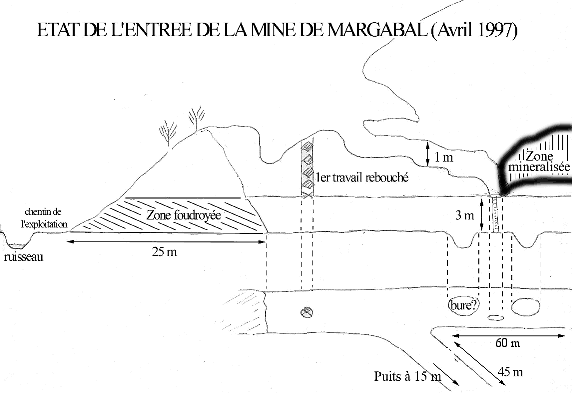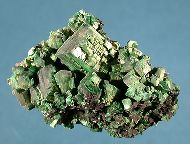|
|
General
information on torbernite:
Secondary mineral of origin, torbernite
is formed by deterioration of other uranium minerals. Exceptional samples come
from Zaire, Gabon, of Australia Meridionale and North Carolina (the United States).
"In Europe, the best samples come from France, in particular of the small
search for Margabal (Aveyron), where were met in the years 1960, of the crystals
being able to reach 2 cm length and formant of the very spectacular groups, associated
sometimes with smoked out quartz. The mine of the Wood-Blacks (Haute-Loire), now
abandoned, is famous also for the crystal carpets of several square decimetres
which have at one time made up a genuine ore ". (source MNHN).
It should be
noted that torbernite is present in all the uranium-bearing ore deposits containing
of copper.
| Commune : Entraygues-sur -Truyere Coordinates
: Type
of work : Extracted tonnage : 1,5 T of Uranium |
Mineralogy :
TORBERNITE - Out of centimetric crystals. The most beautiful known French samples come from this site. Presents itself on granitic gangue (kaolinized by places), without gangue, or on quartz morion whose size of the crystals is of the order of the centimetre. Actually, it acts of metatorbernite (dehydrated torbernite).
Torbernite of Margabal
(4.5 X 2.5 cm)Classify: Phosphates
Crystalline system: quadratic
Chemical formula (Torbernite): Cu (UO2 PO4)2. 12H2O
Chemical formula (Metatorbernite): Cu (UO2 PO4)2. 8H2O
Hardness: 2 to 2,5
Density: 3,3 to 3,7
Cleavage: perfect
Fracture: irregular
Color: green
Color of the powder: clear green
Glare: vitreous with beaded
Fluorescence: none
AUTUNITE - Centimetric Crystals. Autunite alone would have been found only in one "chimney" at the time of the reopening of work. If not, it is often present under torbernite, or closely associated, which confers on the samples the property to be fluorescent with UV (big and short wavelength).
PYRITE - out of crystals of a few millimetres dispersed and oxidized on quartz morion.
It should be noted that samples presenting of the prints of cubes in quartz (as in Echassieres - To combine) were found. No current study (2002) makes it possible to say if it acted of pyrite, or of a uranium-bearing mineral dissolves.
Origin of the name
:
Source: Emile MARC, collector - Entraygues-on-Truyere.
A couple of people lived between two rocks, under one roof of wood and ferns. They lived chichement and in a a little wild way. Five or six children were born in this place, and all the family was regarded as "not having all her mental capacities (or physics)". One day the hut burned and all was destroyed. The town hall of Entraygues then decided to build a correct house to them, which would be, now below located the road which goes up to Las Carriols, near the small brook which comes from the mine. Margabal, in patois, would thus come from "badly formed"... like the house or the family.
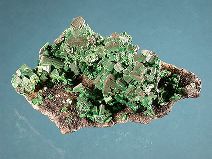 Torbernite on morion quartz gangue Margabal (7.0 X 5.0 cm) | 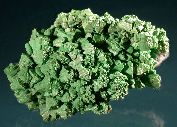 Cluster of crystals in "peak" Margabal (9.0 X 7.0 cm) |
History of the prospections :
1957 - 1960: The research tasks and the exploitation are led by the CFMU (French Company of the Uranium Ores). E Marc remembers to have seen, in the office of the foreman, the crystallized torbernite parts, exceptional from their size and their crystallization.
1960: Caving of the entry at a distance of approximately 25 m. There does not remain then of work that the remainder of a trench, encumbered by blocks and spoil.
1980 (surroundings of): Two collectors living in Aveyron dig in spoil of the entry and find in satellite filonnets, some crystallized parts. They stop after many efforts, because two bulky blocks prevent any continuation of work. The access to the mine being made very discreetly (still valid recommendation today! ! !), the contribution of large material is not possible. A few times later, another character starts to dig a small level gallery, with the top of the old gallery which is inserted more in "Puech de Soulouze". This one seems to follow the quartz morion seam. No information filters as for the results of work. This gallery fills of water gradually...
March 1996: Another Aveyron collector starts, alone(!), to dig a vertical hole, in the granite, after having taken measurements in order to be certain to arrive in the principal gallery. Work is done only with the mass and the graver. Mow, it requires of the assistance to those which had dug in the Eighties. They take turns 8 a.m. to 5 p.m., with 15 minutes of pause to lunch. A third character comes to join a short moment. Work is carried out for March 22 until May 21. At the bottom of the hole, the rock sounds "hollow". The access to the mine is done at the end of 35 working days entirely manual (that is to say a 350 hours total), by a 4 depth meters shafts.
The mine thus appears out of V, coarsely directed NS, with a gallery of 50 m (on the right) moving towards the outside of the mountain. The gallery of left (65 m), on the contrary, moves away from the slope of Puech.
Gallery
of left:
It is the healthiest gallery: the granite is hard, nonfriable.
Water comes from the coal face, and runs out towards the exit. The uranium seam
was traced on 65 Mr. Two cavities of the width of the gallery are visible with
the floor. Are this bore-holes (interior shaftss) filled? No information makes
it possible to affirm it for the moment. Quartz morion géodes are then visible
with the ceiling. A whole chain is distinguished until the forefield. However,
the zone richest in torbernite seems to be closest to the entry. Indeed, at the
time of traverses mine, the only visible evidence are two small green spots 8
cm in diameter, located at 3,50m height. The second spot delivers
a géode,
filled with quite green torbernite of 50cm of depth. Using scales out of wooden
(destroyed thereafter) and of a large metal pole, they succeed in extracting from
this pocket of the mineral-bearing parts (without escaping from an arrival from
very cold water). Those are caught up with with the flight when they fall. It
is useless to specify that after such a labour, no part escapes from the hands!
Each one then finds in possession of well crystallized parts energy of the chestnut-green,
with the sharp green. Parts whose size goes until about fifteen centimetres were
extracted.
Gallery of right-hand side:
This second gallery of 50 m is not very healthy. It, it, was also traced while following a mineralized bog manganese seam, but the boxing granite is friable. Casings had been installed by places, and were quickly degraded. A descending shaft at summer dug of the interior, but did not join surface. No contemporary work of search for crystallizations was still undertaken... what is included/understood.
The scales are then destroyed, and the hole of stopped access. The discoveries remain secret then...
January 1997: After having located how evolved/moved the geodes discovered in 1996, one of the protagonists turns over on the site helped by one of his/her friends, him also collector, and takes again the starter of gallery drowned in direction of the geodes discovered at the time of the first visit. This one measures on average 1 m of width, 1,30 m height and, while following a mineral-bearing quartz seam morion (1 with 3cm of thickness) without ANY torbernite trace, continues on 10m. and is located almost at the top of the gallery of left. Work is done "with the hand", in a granite of great hardness. After 11 working days to two, work is abandoned.
May - June 1997: Work is resumed - by the same actors! - One arrives then at the site of the emptied geode lower part. Some small parts are still extracted, but quality remains poor, compared to what will follow... A few tens of centimetres further, after "having passed" 3 successive geodes , a "chimney" of 3,50m height filled of torbernite and crystallized autunite is presented. It is the large discovery. A part of 50cm approx. then is extracted, entirely crystallized. Quality is there: green crystals intense, brilliances and sometimes reaching 2 cm. In 1997, 430 working hours were necessary to arrive at this result.
At the end of 1997: The building site is then taken again by another character who discovers in his turn an extremely rich zone and of quality: the "chimneys" go up to 3 meters height. The part presented at the Natural history museum of Paris (50 cm in height) comes from it, as well as the major part of the parts presented out of purse during the year which follows.
1998: The reopening of Margabal is not any more one secrecy. The mineralogical community is well-informed... A succession of building sites will proceed there, with more or less chance. The successive visits lead then to a removal of pit props (which follows upon the small gallery of access of 7-8 meters) which measures up to 3 meters height, and extends on approximately 8 meters. All spoil is sent in the gallery of 65 m, filling it gradually.
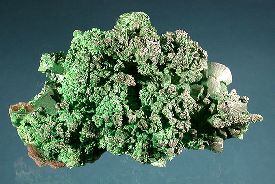 Superb torbernite in crystal association in "open book" and stalactiformes Margabal (9.0 X 7.0 cm) |
Conclusion
: In 1978, the rumour made state of a "strongly mineral-bearing seam which had
been crossed and not followed". The old parts would come from it. But, it was
known as that the mine could nothing any more give, the ore deposit being exhausted.
The tenacity of some, and eagerness with work made it possible to prove the opposite...
Once more, the mineralogical parts of very high mineralogical level left this
ore deposit.
Let us recall that all this work was completed without preliminary
authorizations as well of the owner of the site as of that of the basement.
If the discoveries were exceptional, it does not remain about it less than they
were the fruit of the chance and the chance of these clandestine discoverers!
